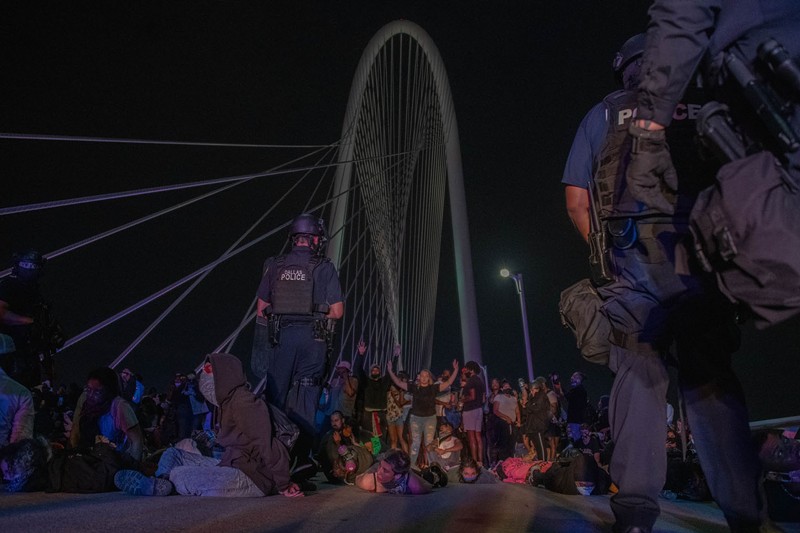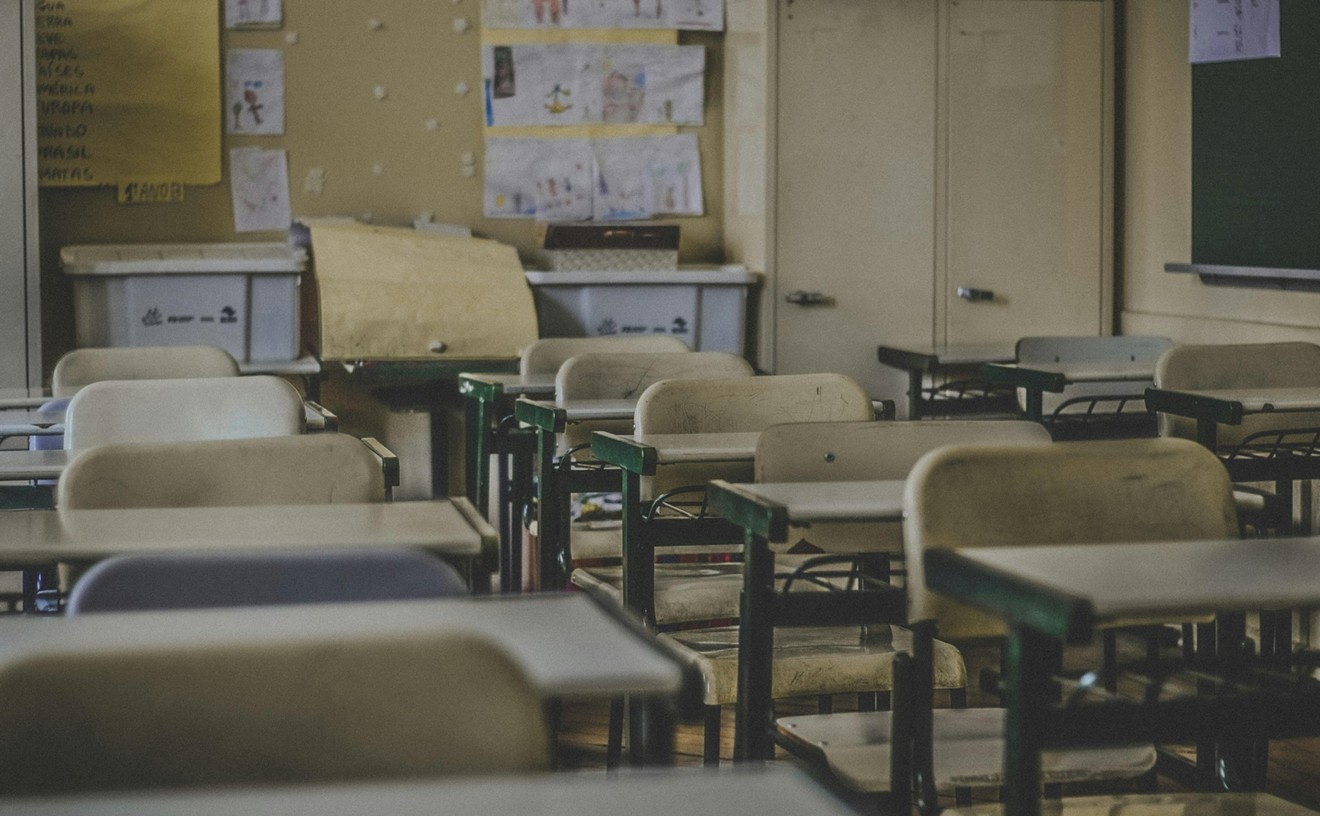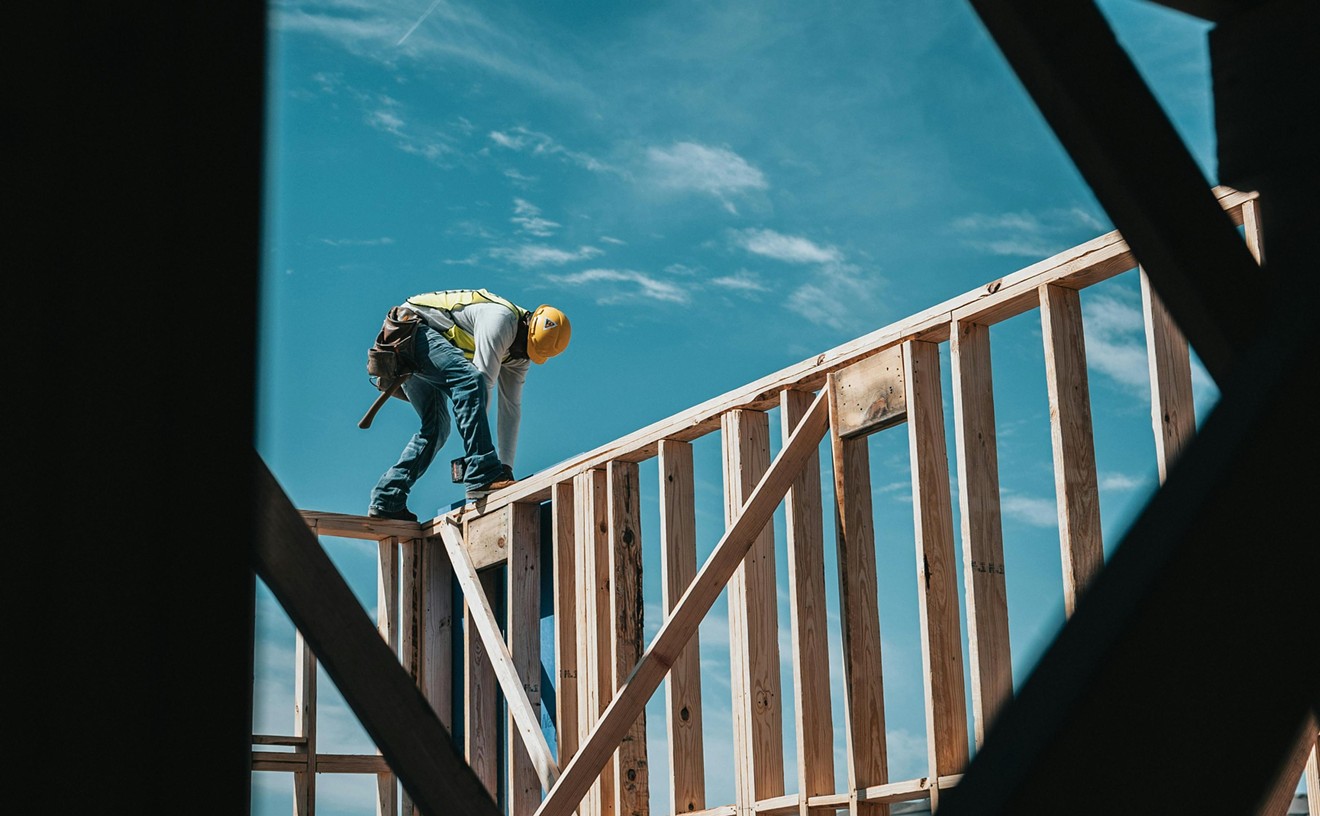When the marchers reached the Woodall Rodgers Freeway interchange, they made a left turn, walking onto the Margaret Hunt Hill Bridge, a span that runs across the Trinity River. Protesters chanted "Hands up, don't shoot!" as they made their way across the bridge. At the west end of the bridge, a line of Dallas police officers, Texas National Guard troops and Texas Highway Patrol troopers was waiting.
Suddenly, popping sounds rang out, sparks flew and smoke billowed across the bridge. What had been a peaceful protest quickly fell into chaos as protesters began scrambling back toward the east end of the bridge, only to find a line of officers closing in on them from that side, as well.
Protesters, finding themselves bottled up between two lines of police, sat down on the bridge and held their hands in the air. Over a speaker, an officer told them to lie down on their stomachs and put their hands behind their backs. Over the next hour, police zip-tied protesters' hands and took down their names. Hours later, officers took the protesters back to Frank Crowley Courthouse and released them.
"We will not break the law in the city of Dallas. Period. Next question." — Police Chief U. Renee Hall
tweet this
Police arrested 674 protesters on the bridge. Police initially said protesters would be charged with obstructing a freeway. But days later, police Chief U. Renee Hall announced the department wouldn't pursue charges against them.
The technique police used to hem the crowd in is a controversial tactic called kettling. Police use a combination of natural barriers, barricades and cordons of officers to corral protesters into a small area, in some cases holding them there for hours with no access to food, water or bathrooms. The practice has been condemned by human rights organizations because, in most cases, police end up detaining or arresting not only lawbreakers, but also peaceful protesters, legal observers, journalists and people who happened to be walking by at the time.
'They trapped us on purpose'
During a news conference on the morning after the demonstration, Chief Hall defended the department's handling of the protest. But when Dallas Morning News reporter Cassandra Jaramillo asked Hall about the department's use of kettling, the chief shut the question down."We will not break the law in the city of Dallas. Period," she said. "Next question."
Hall herself characterized the demonstration as entirely peaceful. But she said protesters broke the law by marching in a lane of traffic on the bridge. She said officers warned protesters that, if they went onto the bridge, they could be arrested.
But Dede Alexander insists that isn't what happened. Alexander is one of the hundreds of protesters who were detained on the bridge. She said police gave them no such warning. In fact, she said, the group had meant to keep marching along Riverfront Avenue, but officers blocked their path and diverted them onto the bridge.
"They ushered us onto the bridge," Alexander said.
As protesters walked onto the bridge, Alexander said she didn't sense any uneasiness or agitation either among other demonstrators or the police. For the first eight minutes or so, everything seemed normal. But then, there was confusion. From her place in the back of the crowd, she couldn't see the line of officers at the west end of the bridge. After a few minutes, she heard a series of popping sounds and saw people running back toward the east end of the bridge.
As it became clear that the group was hemmed in on both sides, organizers told protesters to sit down peacefully. One by one, officers picked protesters up and zip tied their hands. A white police officer was complaining loudly that he was tired of dealing with protests. Alexander, who is black, told him to imagine how tired he'd be if he had to deal with everything the protesters were marching against.
"I'm not talking to you," the officer shot back.
"Jamming people together is bad. Putting them in jail is worse." — Andre Segura, ACLU of Texas
tweet this
Alexander, who ran for the District 10 Dallas City Council seat last year, said it was no accident that police diverted the protesters onto the bridge only to arrest them minutes later for being there.
"This was completely orchestrated. This was kettling," she said. "It seemed like they trapped us on purpose. They set us up to look like this so they could look like the heroes."
Alexander thinks the way the police handled Monday night's protest laid bare the same problems that sparked the protests in the first place. The police need to be demilitarized, she said, and city leaders need to go through the department's budget thoroughly and cut it drastically. She also thinks Hall needs to resign or be fired.
Andre Segura, legal director of the America Civil Liberties Union of Texas, said it's worrisome that police would resort to kettling since, with some exceptions, the protests in Texas have been largely peaceful. When large groups of protesters are arrested en masse during a kettle, it raises serious questions about probable cause, Segura said. He argued that kettling and mass arrests are unnecessary, and they only escalate confrontations between police and protesters. Instead, police should listen to the protesters, try to engage with them and find ways to de-escalate the situation.
Any police tactic that forces large groups of people into a small area, and then possibly taking them to jail, is particularly dangerous at a time when cases of COVID-19 are on the rise.
"Jamming people together is bad. Putting them in jail is worse," he said.
Troubling history
The practice of kettling has a decades-long history in American policing and has often led to multi-million-dollar legal settlements, investigations and, in at least one case, indictments against police officers.In 2002, Washington, D.C.'s, Metropolitan Police Department used the tactic, which is also known as "trap and detain," to arrest about 400 people during anti-globalization protests in Pershing Park. Police hog-tied protesters and left them that way for hours. The District would eventually pay more than $10 million in class action settlements as a result.
In a report released in 2004, the Washington City Council's Committee on the Judiciary denounced the practice, saying it "has at times kept demonstrators detained for considerable lengths of time, against their will.
"It should never be used on nonviolent demonstrators or in the absence of the potential for unlawful activity," the committee concluded. "To do so is a violation of current MPD policy and is arguably tantamount to, at best, disruption of individuals’ First Amendment rights to demonstrate and, at worst, false arrest."
More recently, protests and riots erupted in St. Louis in 2017 after a jury acquitted former St. Louis police officer Jason Stockley of first-degree murder. Stockley shot and killed Anthony Lamar Smith, a 24-year-old black man, after a pursuit.
During a protest in downtown St. Louis, police set up a kettle, then fired bean bags, pepper balls and mace into the crowd. They then set about arresting more than 100 people, including protesters, legal observers and bystanders who happened to get caught up in the kettle.
Among those arrested were a U.S. Air Force officer who lived in the neighborhood, a reporter for the St. Louis Post-Dispatch and a police detective who was working undercover during the protests. Police savagely beat and kicked the undercover officer during the melee.
A federal grand jury indicted four officers the following year, accusing them of beating their colleague and then covering it up. The indictment also says officers “expressed disdain” for protesters and “excitement about using unjustified force against them and going undetected while doing so.”
Tim Maher, a professor of criminal justice at the University of Missouri-St. Louis, said kettling is a legitimate crowd control tactic. But it should only be used in dire circumstances, where police are significantly outnumbered and protests are getting violent or out of control, he said. Police may also have legitimate cause to use the tactic in cases where protesters are blocking roadways, preventing emergency vehicles from getting through, he said.
Because there's such a high likelihood that peaceful protesters and bystanders will get caught up in a kettle, Maher said police have a responsibility, once they've detained everyone, to weed out lawbreakers and let everyone else go.
Maher, who served for 22 years as a police officer in suburban St. Louis, said police departments across the country need to do more to improve their relationships with communities of color. Maher recently completed a study in which he interviewed police officers around the St. Louis metro area about what changes had taken place in their departments since Michael Brown was shot and killed in nearby Ferguson in 2014. Most said their leaders were doing more to make their officers aware of systemic racism in their own departments, but every incident like the one in Minneapolis sets that work back, he said.
On Friday afternoon, more than 200 people signed up to speak for one minute each during a special Dallas City Council meeting that was called in response to the protests. Many of the speakers called for an end to police brutality against black people. Others condemned the police department's handling of the protests, including Monday night's kettle on the Margaret Hunt Hill Bridge.
Among those speakers was David Villalobos, a campaign coordinator with the Texas Organizing Project, a community organizing group. After years of peaceful protesting, last week on the bridge marked the first time Villalobos had ever been shot at with any kind of projectile, he said.
When police began firing projectiles and smoke, the crowd went into chaos, Villalobos said. Eventually, some gathered enough composure to take a knee and begin a chant as police pelted them with what protesters suspected was tear gas. At any point, a protester could have fallen off the bridge, he said, and the way police crammed protesters together put everyone at risk.
"I was put in a DART bus with about 30 other people with no regard to social distancing, (then) taken to Frank Crowley Courthouse in a paddy wagon with nine other people," he said. "For the record, I hope I don’t have COVID-19 because of these interactions.”













